BCO212 Business Finance: Investment Analysis and Risk Assessment
VerifiedAdded on 2022/09/11
|11
|1686
|12
Homework Assignment
AI Summary
This business finance assignment analyzes three scenarios involving investment decisions and risk assessments. Scenario A focuses on retirement planning, evaluating a financial product with a guaranteed dividend and comparing it to an alternative investment option, considering factors like age, savings, and potential monthly spending. Scenario B assesses the net present value of investing in a house versus an interest-earning investment, emphasizing the importance of capital accumulation. Scenario C examines investment in a business, calculating the cost, income, profit, and various yield metrics. The assignment further delves into different types of financial risks, including credit, liquidity, market, operational, solvency, regulatory, legal, and tail risks, with examples. Finally, the assignment applies these risk concepts to real-world events, categorizing them based on the type of financial risk they represent, such as legal or market risk, providing a comprehensive overview of financial concepts and decision-making.

Running head: BUSINESS FINANCE
Business Finance
Name of the Student:
Name of the University:
Author’s Note:
Business Finance
Name of the Student:
Name of the University:
Author’s Note:
Paraphrase This Document
Need a fresh take? Get an instant paraphrase of this document with our AI Paraphraser
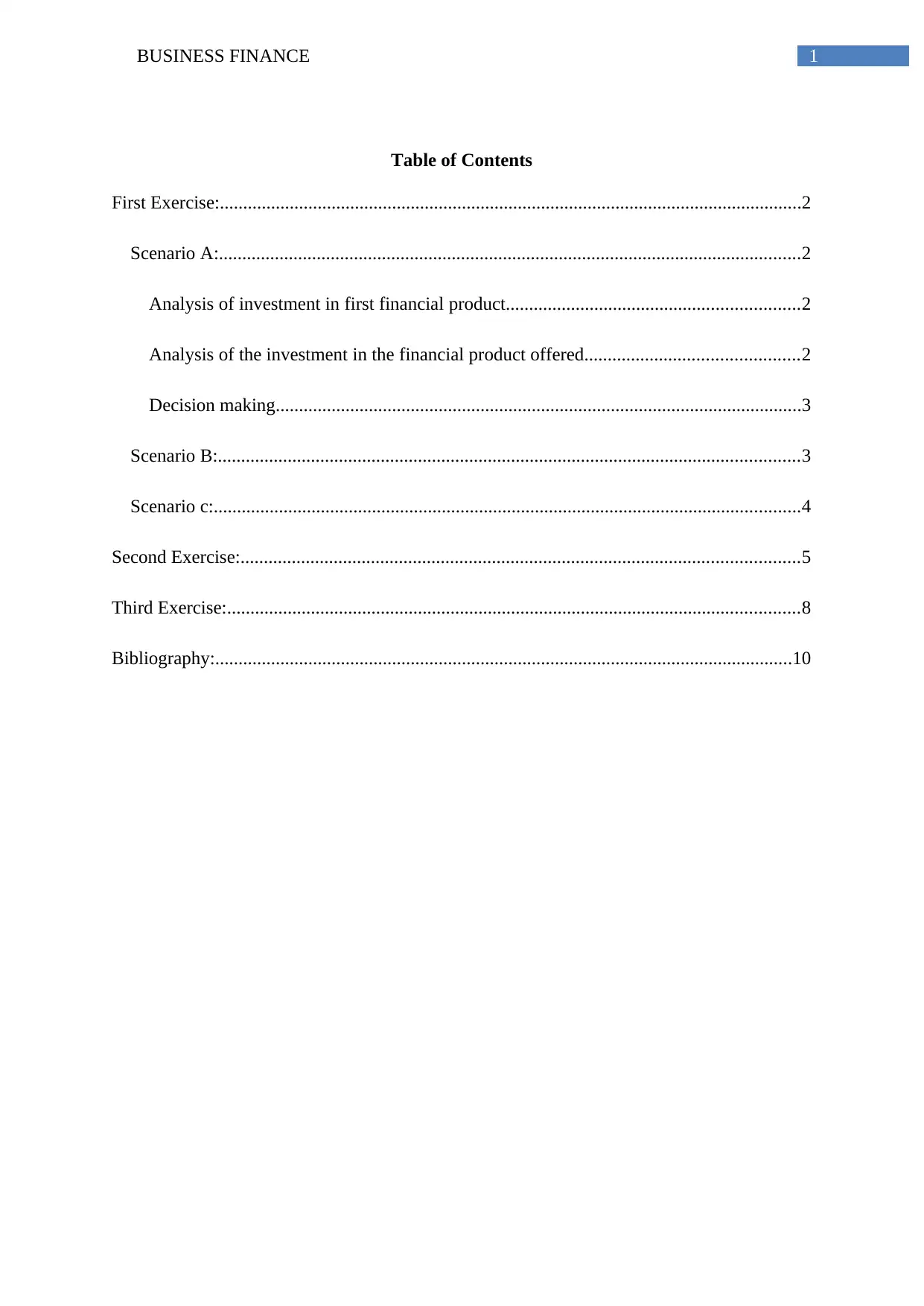
1BUSINESS FINANCE
Table of Contents
First Exercise:.............................................................................................................................2
Scenario A:.............................................................................................................................2
Analysis of investment in first financial product...............................................................2
Analysis of the investment in the financial product offered..............................................2
Decision making.................................................................................................................3
Scenario B:.............................................................................................................................3
Scenario c:..............................................................................................................................4
Second Exercise:........................................................................................................................5
Third Exercise:...........................................................................................................................8
Bibliography:............................................................................................................................10
Table of Contents
First Exercise:.............................................................................................................................2
Scenario A:.............................................................................................................................2
Analysis of investment in first financial product...............................................................2
Analysis of the investment in the financial product offered..............................................2
Decision making.................................................................................................................3
Scenario B:.............................................................................................................................3
Scenario c:..............................................................................................................................4
Second Exercise:........................................................................................................................5
Third Exercise:...........................................................................................................................8
Bibliography:............................................................................................................................10
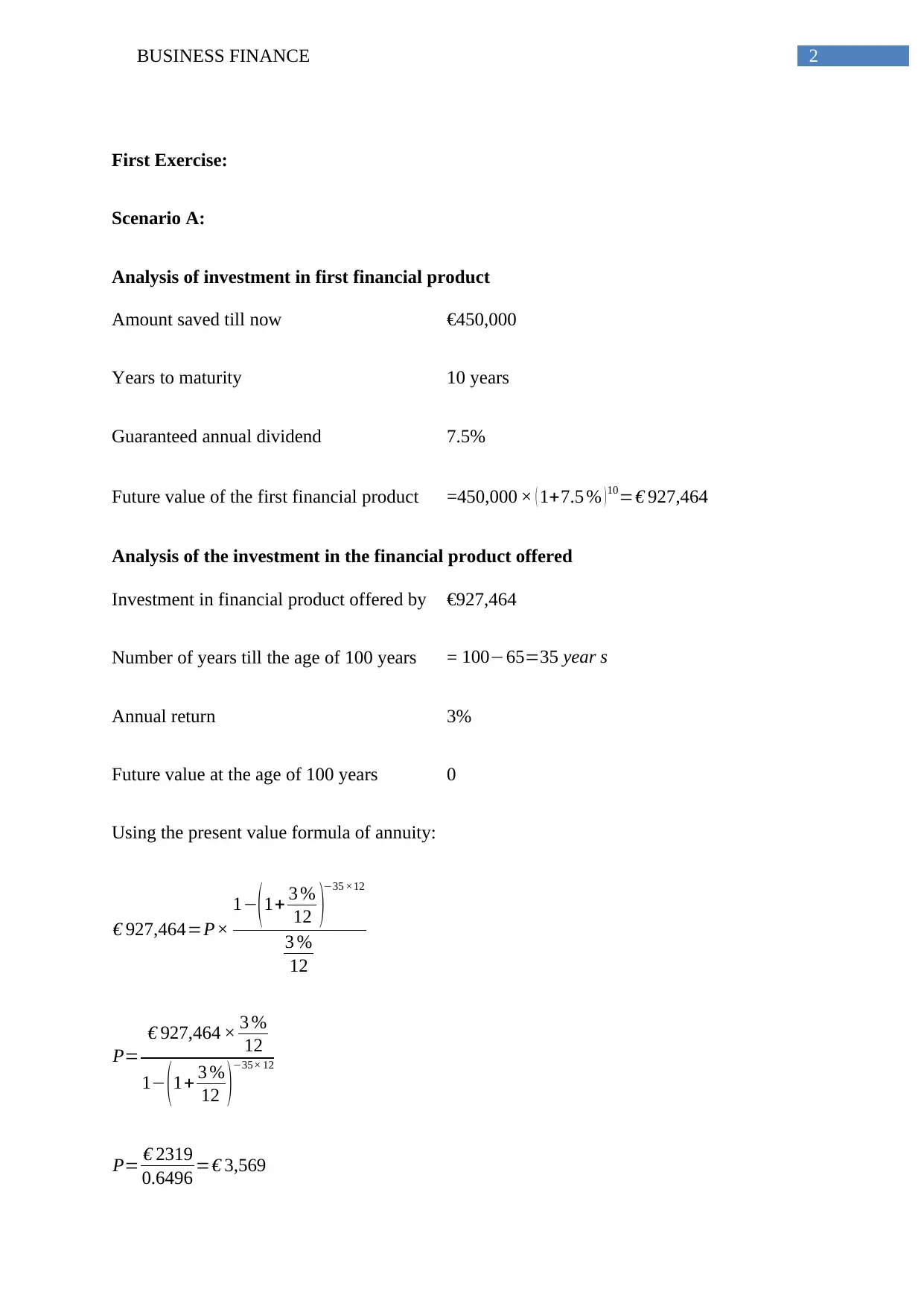
2BUSINESS FINANCE
First Exercise:
Scenario A:
Analysis of investment in first financial product
Amount saved till now €450,000
Years to maturity 10 years
Guaranteed annual dividend 7.5%
Future value of the first financial product =450,000 × ( 1+7.5 % ) 10=€ 927,464
Analysis of the investment in the financial product offered
Investment in financial product offered by €927,464
Number of years till the age of 100 years = 100−65=35 year s
Annual return 3%
Future value at the age of 100 years 0
Using the present value formula of annuity:
€ 927,464=P×
1−(1+ 3 %
12 )−35 ×12
3 %
12
P=
€ 927,464 × 3 %
12
1− (1+ 3 %
12 )−35× 12
P= € 2319
0.6496 =€ 3,569
First Exercise:
Scenario A:
Analysis of investment in first financial product
Amount saved till now €450,000
Years to maturity 10 years
Guaranteed annual dividend 7.5%
Future value of the first financial product =450,000 × ( 1+7.5 % ) 10=€ 927,464
Analysis of the investment in the financial product offered
Investment in financial product offered by €927,464
Number of years till the age of 100 years = 100−65=35 year s
Annual return 3%
Future value at the age of 100 years 0
Using the present value formula of annuity:
€ 927,464=P×
1−(1+ 3 %
12 )−35 ×12
3 %
12
P=
€ 927,464 × 3 %
12
1− (1+ 3 %
12 )−35× 12
P= € 2319
0.6496 =€ 3,569
⊘ This is a preview!⊘
Do you want full access?
Subscribe today to unlock all pages.

Trusted by 1+ million students worldwide
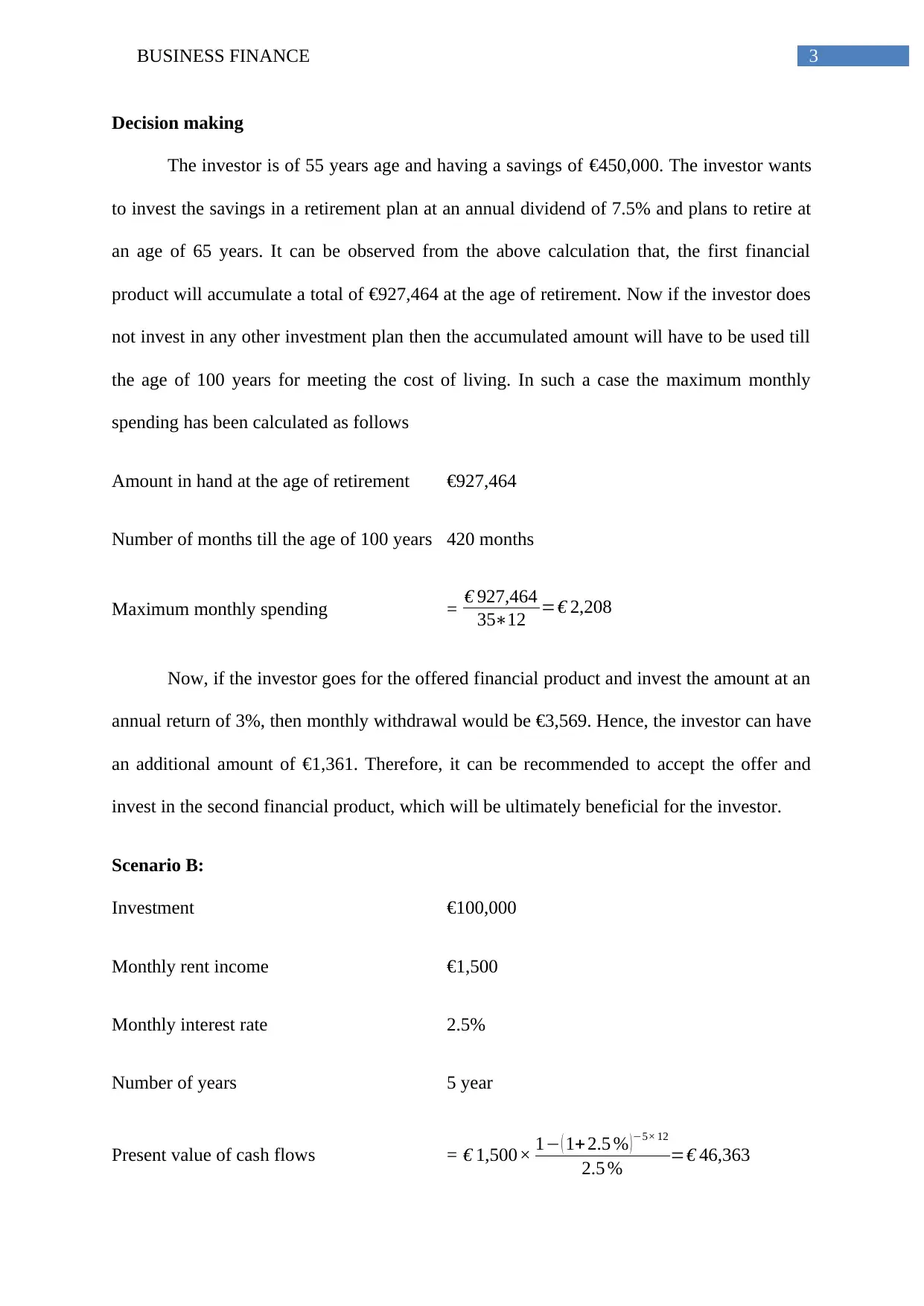
3BUSINESS FINANCE
Decision making
The investor is of 55 years age and having a savings of €450,000. The investor wants
to invest the savings in a retirement plan at an annual dividend of 7.5% and plans to retire at
an age of 65 years. It can be observed from the above calculation that, the first financial
product will accumulate a total of €927,464 at the age of retirement. Now if the investor does
not invest in any other investment plan then the accumulated amount will have to be used till
the age of 100 years for meeting the cost of living. In such a case the maximum monthly
spending has been calculated as follows
Amount in hand at the age of retirement €927,464
Number of months till the age of 100 years 420 months
Maximum monthly spending = € 927,464
35∗12 =€ 2,208
Now, if the investor goes for the offered financial product and invest the amount at an
annual return of 3%, then monthly withdrawal would be €3,569. Hence, the investor can have
an additional amount of €1,361. Therefore, it can be recommended to accept the offer and
invest in the second financial product, which will be ultimately beneficial for the investor.
Scenario B:
Investment €100,000
Monthly rent income €1,500
Monthly interest rate 2.5%
Number of years 5 year
Present value of cash flows = € 1,500× 1− ( 1+ 2.5 % )−5× 12
2.5 % =€ 46,363
Decision making
The investor is of 55 years age and having a savings of €450,000. The investor wants
to invest the savings in a retirement plan at an annual dividend of 7.5% and plans to retire at
an age of 65 years. It can be observed from the above calculation that, the first financial
product will accumulate a total of €927,464 at the age of retirement. Now if the investor does
not invest in any other investment plan then the accumulated amount will have to be used till
the age of 100 years for meeting the cost of living. In such a case the maximum monthly
spending has been calculated as follows
Amount in hand at the age of retirement €927,464
Number of months till the age of 100 years 420 months
Maximum monthly spending = € 927,464
35∗12 =€ 2,208
Now, if the investor goes for the offered financial product and invest the amount at an
annual return of 3%, then monthly withdrawal would be €3,569. Hence, the investor can have
an additional amount of €1,361. Therefore, it can be recommended to accept the offer and
invest in the second financial product, which will be ultimately beneficial for the investor.
Scenario B:
Investment €100,000
Monthly rent income €1,500
Monthly interest rate 2.5%
Number of years 5 year
Present value of cash flows = € 1,500× 1− ( 1+ 2.5 % )−5× 12
2.5 % =€ 46,363
Paraphrase This Document
Need a fresh take? Get an instant paraphrase of this document with our AI Paraphraser
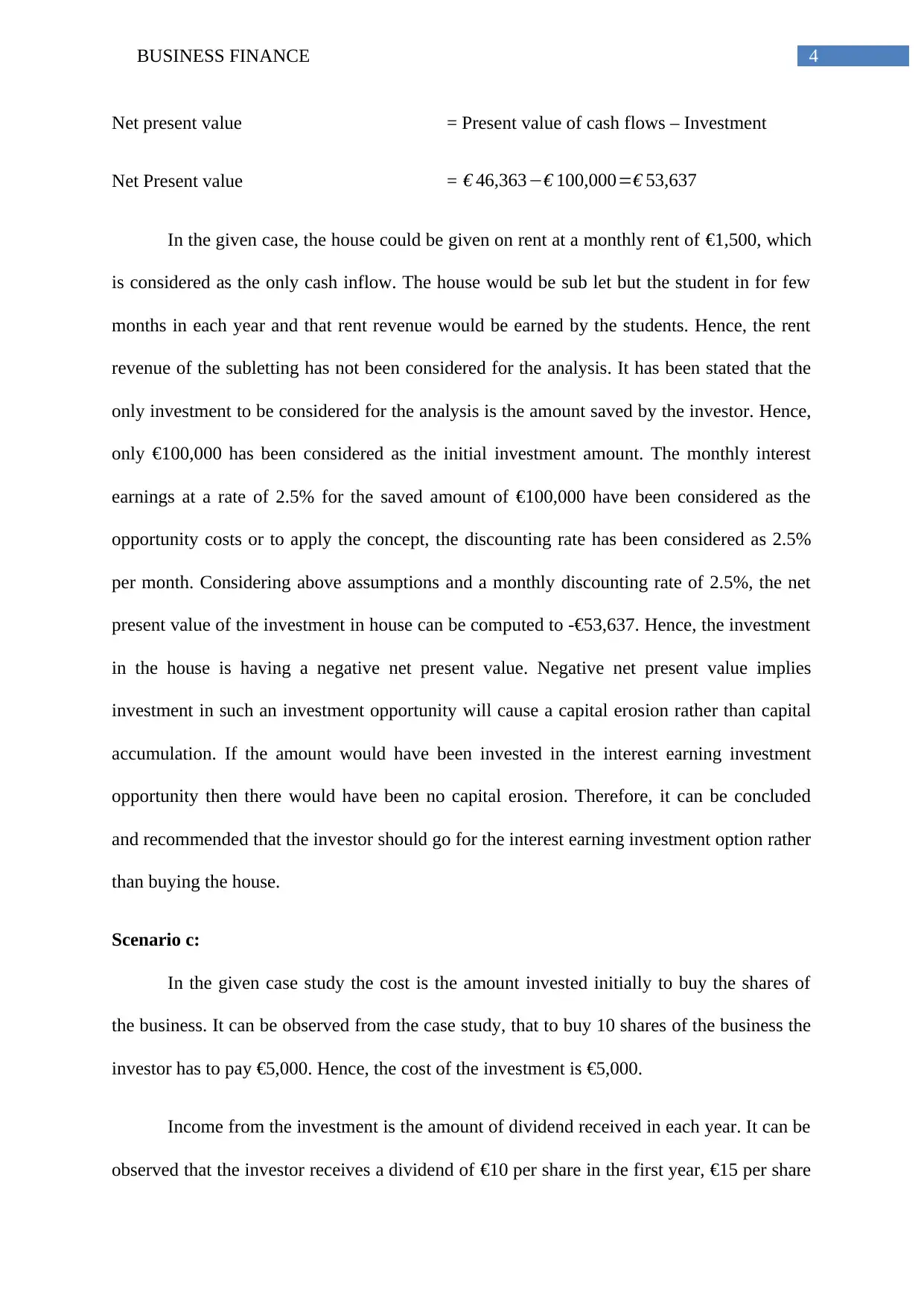
4BUSINESS FINANCE
Net present value = Present value of cash flows – Investment
Net Present value = € 46,363−€ 100,000=€ 53,637
In the given case, the house could be given on rent at a monthly rent of €1,500, which
is considered as the only cash inflow. The house would be sub let but the student in for few
months in each year and that rent revenue would be earned by the students. Hence, the rent
revenue of the subletting has not been considered for the analysis. It has been stated that the
only investment to be considered for the analysis is the amount saved by the investor. Hence,
only €100,000 has been considered as the initial investment amount. The monthly interest
earnings at a rate of 2.5% for the saved amount of €100,000 have been considered as the
opportunity costs or to apply the concept, the discounting rate has been considered as 2.5%
per month. Considering above assumptions and a monthly discounting rate of 2.5%, the net
present value of the investment in house can be computed to -€53,637. Hence, the investment
in the house is having a negative net present value. Negative net present value implies
investment in such an investment opportunity will cause a capital erosion rather than capital
accumulation. If the amount would have been invested in the interest earning investment
opportunity then there would have been no capital erosion. Therefore, it can be concluded
and recommended that the investor should go for the interest earning investment option rather
than buying the house.
Scenario c:
In the given case study the cost is the amount invested initially to buy the shares of
the business. It can be observed from the case study, that to buy 10 shares of the business the
investor has to pay €5,000. Hence, the cost of the investment is €5,000.
Income from the investment is the amount of dividend received in each year. It can be
observed that the investor receives a dividend of €10 per share in the first year, €15 per share
Net present value = Present value of cash flows – Investment
Net Present value = € 46,363−€ 100,000=€ 53,637
In the given case, the house could be given on rent at a monthly rent of €1,500, which
is considered as the only cash inflow. The house would be sub let but the student in for few
months in each year and that rent revenue would be earned by the students. Hence, the rent
revenue of the subletting has not been considered for the analysis. It has been stated that the
only investment to be considered for the analysis is the amount saved by the investor. Hence,
only €100,000 has been considered as the initial investment amount. The monthly interest
earnings at a rate of 2.5% for the saved amount of €100,000 have been considered as the
opportunity costs or to apply the concept, the discounting rate has been considered as 2.5%
per month. Considering above assumptions and a monthly discounting rate of 2.5%, the net
present value of the investment in house can be computed to -€53,637. Hence, the investment
in the house is having a negative net present value. Negative net present value implies
investment in such an investment opportunity will cause a capital erosion rather than capital
accumulation. If the amount would have been invested in the interest earning investment
opportunity then there would have been no capital erosion. Therefore, it can be concluded
and recommended that the investor should go for the interest earning investment option rather
than buying the house.
Scenario c:
In the given case study the cost is the amount invested initially to buy the shares of
the business. It can be observed from the case study, that to buy 10 shares of the business the
investor has to pay €5,000. Hence, the cost of the investment is €5,000.
Income from the investment is the amount of dividend received in each year. It can be
observed that the investor receives a dividend of €10 per share in the first year, €15 per share
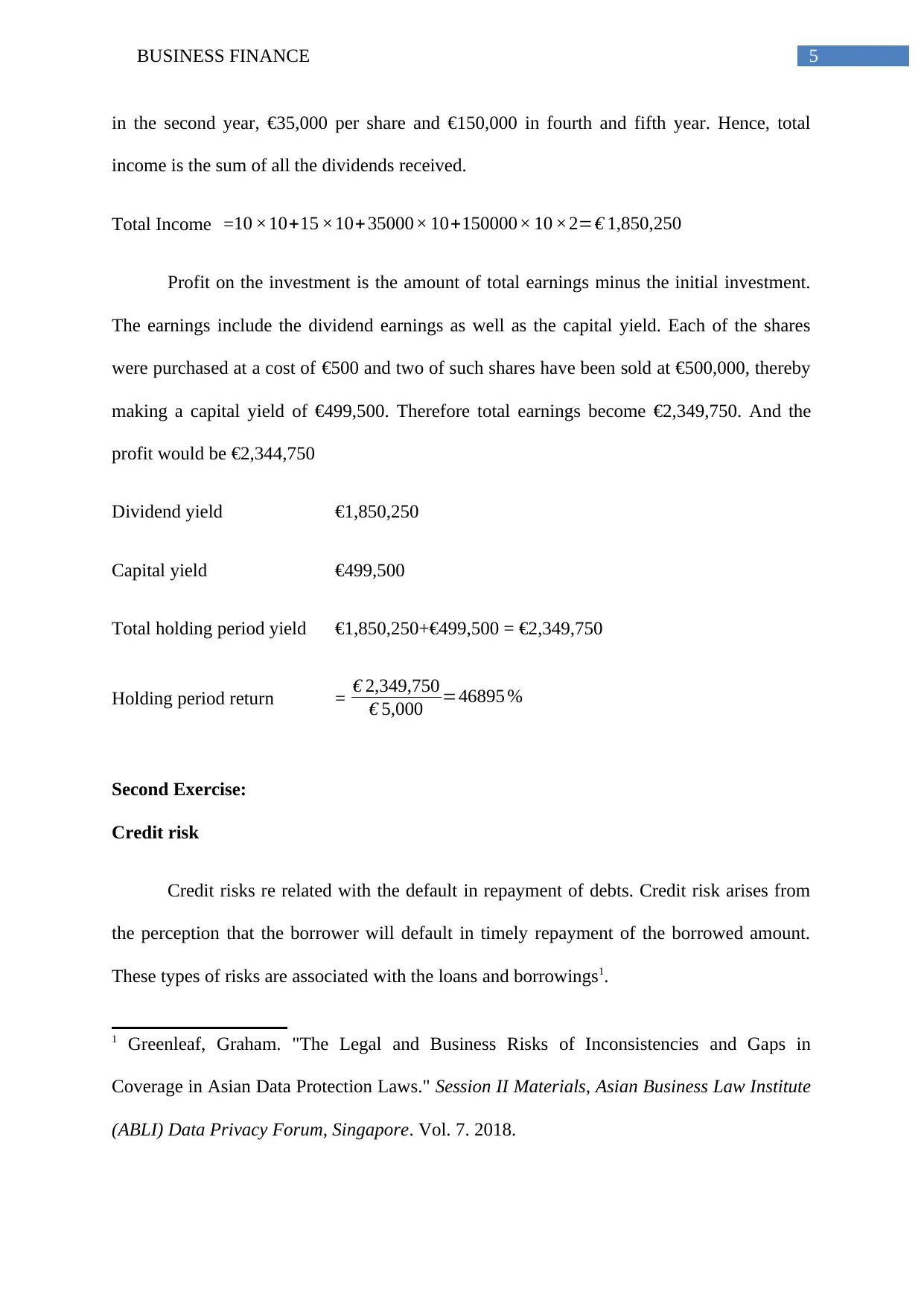
5BUSINESS FINANCE
in the second year, €35,000 per share and €150,000 in fourth and fifth year. Hence, total
income is the sum of all the dividends received.
Total Income =10 ×10+15 ×10+ 35000× 10+150000× 10 ×2=€ 1,850,250
Profit on the investment is the amount of total earnings minus the initial investment.
The earnings include the dividend earnings as well as the capital yield. Each of the shares
were purchased at a cost of €500 and two of such shares have been sold at €500,000, thereby
making a capital yield of €499,500. Therefore total earnings become €2,349,750. And the
profit would be €2,344,750
Dividend yield €1,850,250
Capital yield €499,500
Total holding period yield €1,850,250+€499,500 = €2,349,750
Holding period return = € 2,349,750
€ 5,000 =46895 %
Second Exercise:
Credit risk
Credit risks re related with the default in repayment of debts. Credit risk arises from
the perception that the borrower will default in timely repayment of the borrowed amount.
These types of risks are associated with the loans and borrowings1.
1 Greenleaf, Graham. "The Legal and Business Risks of Inconsistencies and Gaps in
Coverage in Asian Data Protection Laws." Session II Materials, Asian Business Law Institute
(ABLI) Data Privacy Forum, Singapore. Vol. 7. 2018.
in the second year, €35,000 per share and €150,000 in fourth and fifth year. Hence, total
income is the sum of all the dividends received.
Total Income =10 ×10+15 ×10+ 35000× 10+150000× 10 ×2=€ 1,850,250
Profit on the investment is the amount of total earnings minus the initial investment.
The earnings include the dividend earnings as well as the capital yield. Each of the shares
were purchased at a cost of €500 and two of such shares have been sold at €500,000, thereby
making a capital yield of €499,500. Therefore total earnings become €2,349,750. And the
profit would be €2,344,750
Dividend yield €1,850,250
Capital yield €499,500
Total holding period yield €1,850,250+€499,500 = €2,349,750
Holding period return = € 2,349,750
€ 5,000 =46895 %
Second Exercise:
Credit risk
Credit risks re related with the default in repayment of debts. Credit risk arises from
the perception that the borrower will default in timely repayment of the borrowed amount.
These types of risks are associated with the loans and borrowings1.
1 Greenleaf, Graham. "The Legal and Business Risks of Inconsistencies and Gaps in
Coverage in Asian Data Protection Laws." Session II Materials, Asian Business Law Institute
(ABLI) Data Privacy Forum, Singapore. Vol. 7. 2018.
⊘ This is a preview!⊘
Do you want full access?
Subscribe today to unlock all pages.

Trusted by 1+ million students worldwide
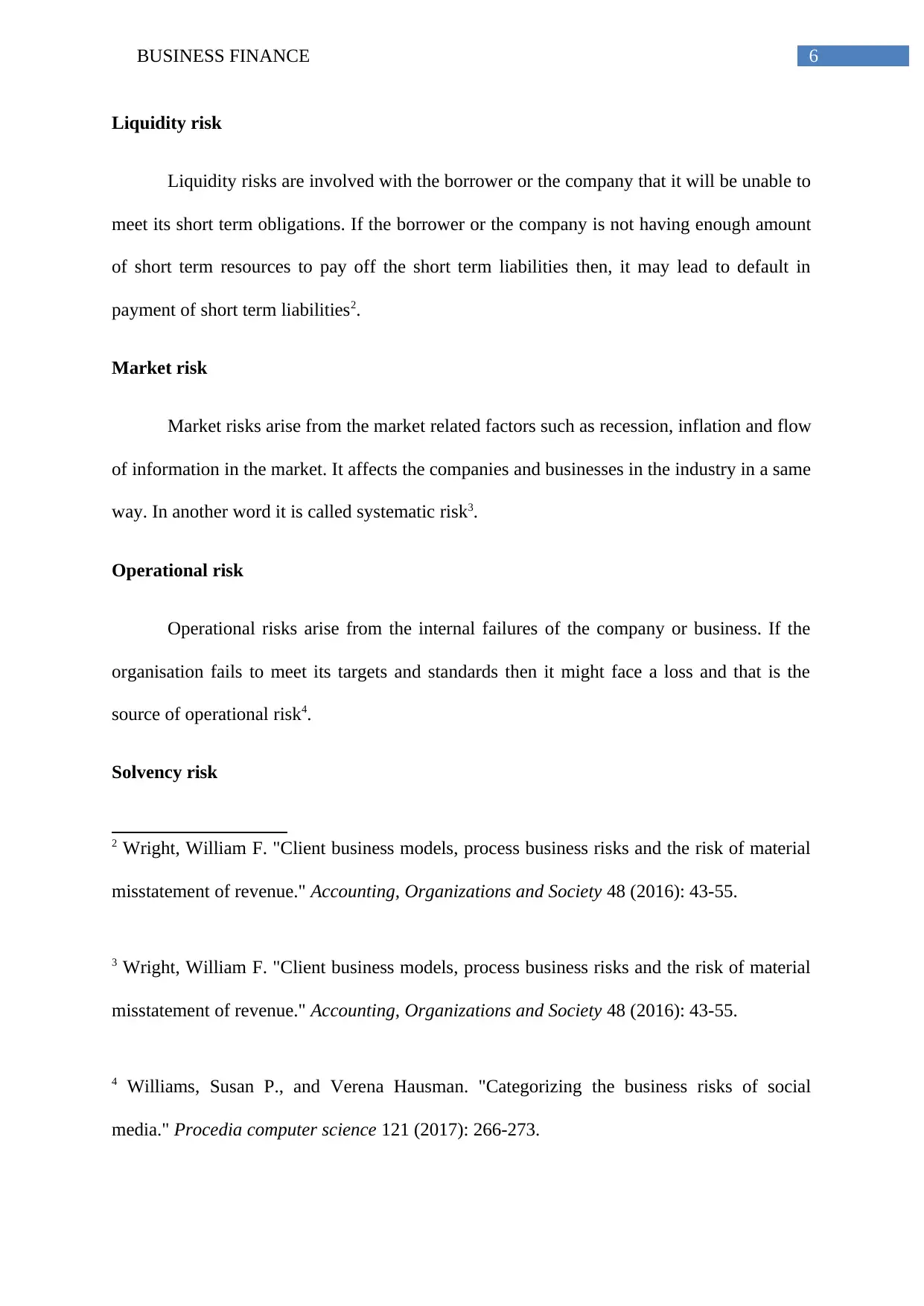
6BUSINESS FINANCE
Liquidity risk
Liquidity risks are involved with the borrower or the company that it will be unable to
meet its short term obligations. If the borrower or the company is not having enough amount
of short term resources to pay off the short term liabilities then, it may lead to default in
payment of short term liabilities2.
Market risk
Market risks arise from the market related factors such as recession, inflation and flow
of information in the market. It affects the companies and businesses in the industry in a same
way. In another word it is called systematic risk3.
Operational risk
Operational risks arise from the internal failures of the company or business. If the
organisation fails to meet its targets and standards then it might face a loss and that is the
source of operational risk4.
Solvency risk
2 Wright, William F. "Client business models, process business risks and the risk of material
misstatement of revenue." Accounting, Organizations and Society 48 (2016): 43-55.
3 Wright, William F. "Client business models, process business risks and the risk of material
misstatement of revenue." Accounting, Organizations and Society 48 (2016): 43-55.
4 Williams, Susan P., and Verena Hausman. "Categorizing the business risks of social
media." Procedia computer science 121 (2017): 266-273.
Liquidity risk
Liquidity risks are involved with the borrower or the company that it will be unable to
meet its short term obligations. If the borrower or the company is not having enough amount
of short term resources to pay off the short term liabilities then, it may lead to default in
payment of short term liabilities2.
Market risk
Market risks arise from the market related factors such as recession, inflation and flow
of information in the market. It affects the companies and businesses in the industry in a same
way. In another word it is called systematic risk3.
Operational risk
Operational risks arise from the internal failures of the company or business. If the
organisation fails to meet its targets and standards then it might face a loss and that is the
source of operational risk4.
Solvency risk
2 Wright, William F. "Client business models, process business risks and the risk of material
misstatement of revenue." Accounting, Organizations and Society 48 (2016): 43-55.
3 Wright, William F. "Client business models, process business risks and the risk of material
misstatement of revenue." Accounting, Organizations and Society 48 (2016): 43-55.
4 Williams, Susan P., and Verena Hausman. "Categorizing the business risks of social
media." Procedia computer science 121 (2017): 266-273.
Paraphrase This Document
Need a fresh take? Get an instant paraphrase of this document with our AI Paraphraser
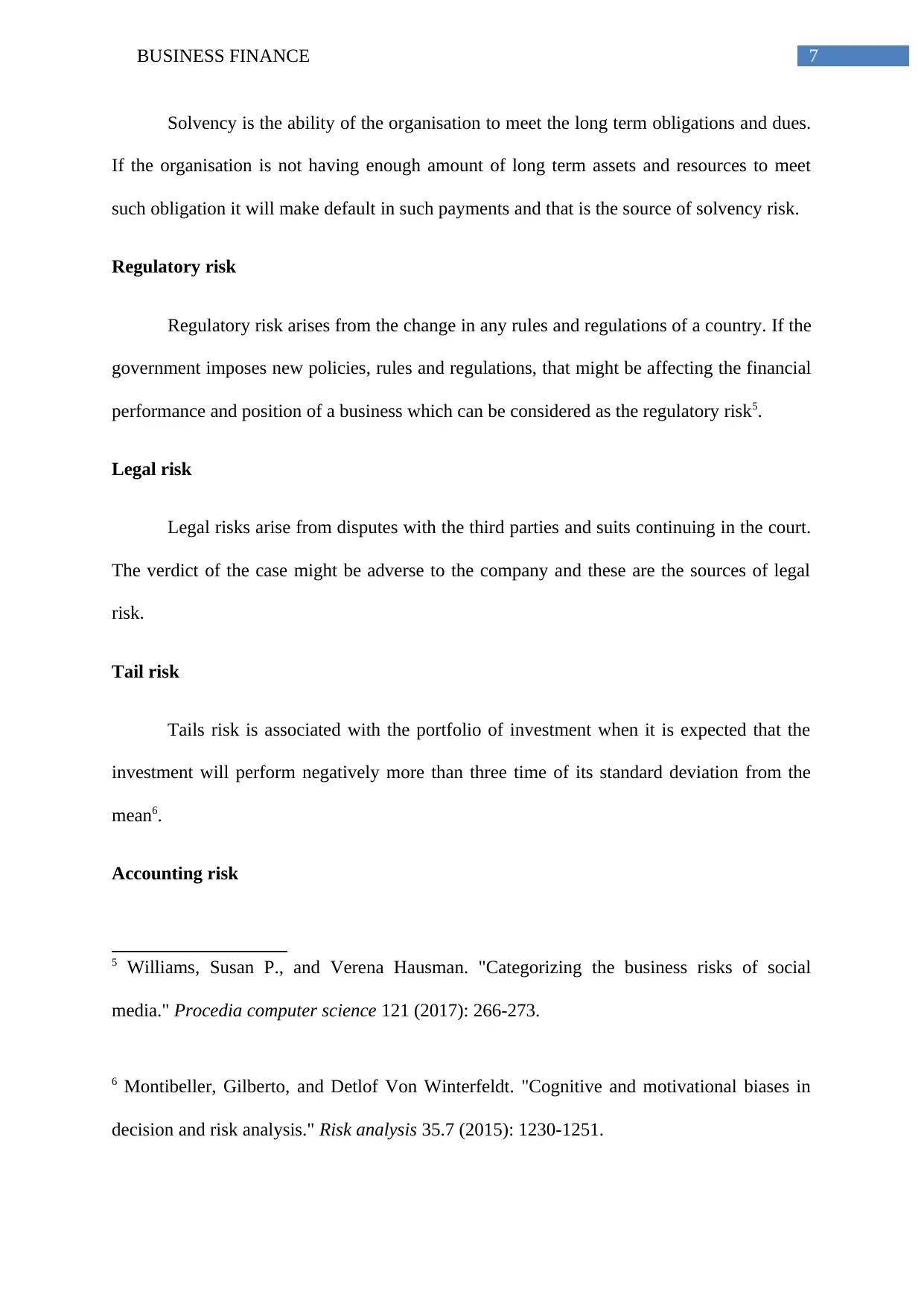
7BUSINESS FINANCE
Solvency is the ability of the organisation to meet the long term obligations and dues.
If the organisation is not having enough amount of long term assets and resources to meet
such obligation it will make default in such payments and that is the source of solvency risk.
Regulatory risk
Regulatory risk arises from the change in any rules and regulations of a country. If the
government imposes new policies, rules and regulations, that might be affecting the financial
performance and position of a business which can be considered as the regulatory risk5.
Legal risk
Legal risks arise from disputes with the third parties and suits continuing in the court.
The verdict of the case might be adverse to the company and these are the sources of legal
risk.
Tail risk
Tails risk is associated with the portfolio of investment when it is expected that the
investment will perform negatively more than three time of its standard deviation from the
mean6.
Accounting risk
5 Williams, Susan P., and Verena Hausman. "Categorizing the business risks of social
media." Procedia computer science 121 (2017): 266-273.
6 Montibeller, Gilberto, and Detlof Von Winterfeldt. "Cognitive and motivational biases in
decision and risk analysis." Risk analysis 35.7 (2015): 1230-1251.
Solvency is the ability of the organisation to meet the long term obligations and dues.
If the organisation is not having enough amount of long term assets and resources to meet
such obligation it will make default in such payments and that is the source of solvency risk.
Regulatory risk
Regulatory risk arises from the change in any rules and regulations of a country. If the
government imposes new policies, rules and regulations, that might be affecting the financial
performance and position of a business which can be considered as the regulatory risk5.
Legal risk
Legal risks arise from disputes with the third parties and suits continuing in the court.
The verdict of the case might be adverse to the company and these are the sources of legal
risk.
Tail risk
Tails risk is associated with the portfolio of investment when it is expected that the
investment will perform negatively more than three time of its standard deviation from the
mean6.
Accounting risk
5 Williams, Susan P., and Verena Hausman. "Categorizing the business risks of social
media." Procedia computer science 121 (2017): 266-273.
6 Montibeller, Gilberto, and Detlof Von Winterfeldt. "Cognitive and motivational biases in
decision and risk analysis." Risk analysis 35.7 (2015): 1230-1251.
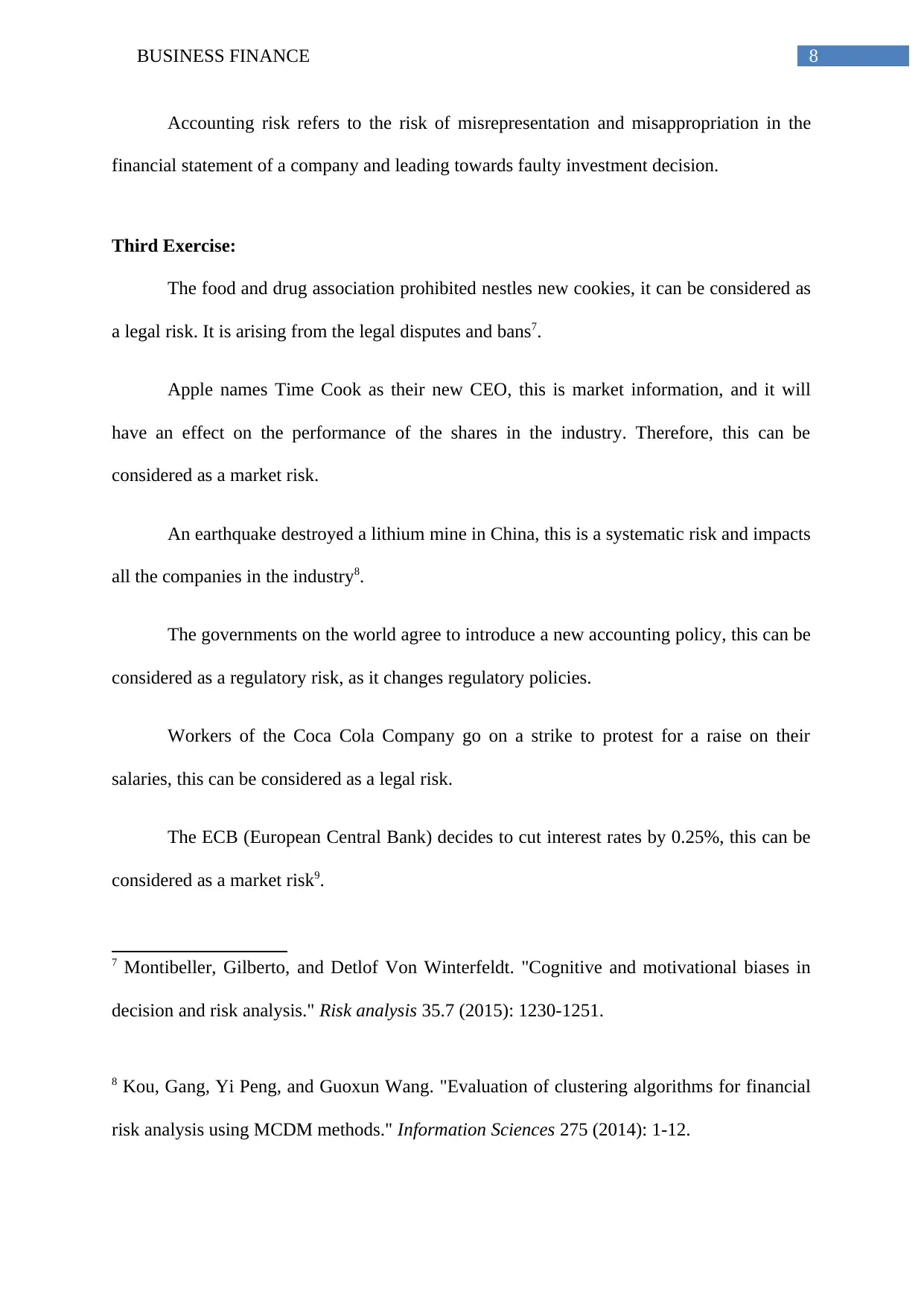
8BUSINESS FINANCE
Accounting risk refers to the risk of misrepresentation and misappropriation in the
financial statement of a company and leading towards faulty investment decision.
Third Exercise:
The food and drug association prohibited nestles new cookies, it can be considered as
a legal risk. It is arising from the legal disputes and bans7.
Apple names Time Cook as their new CEO, this is market information, and it will
have an effect on the performance of the shares in the industry. Therefore, this can be
considered as a market risk.
An earthquake destroyed a lithium mine in China, this is a systematic risk and impacts
all the companies in the industry8.
The governments on the world agree to introduce a new accounting policy, this can be
considered as a regulatory risk, as it changes regulatory policies.
Workers of the Coca Cola Company go on a strike to protest for a raise on their
salaries, this can be considered as a legal risk.
The ECB (European Central Bank) decides to cut interest rates by 0.25%, this can be
considered as a market risk9.
7 Montibeller, Gilberto, and Detlof Von Winterfeldt. "Cognitive and motivational biases in
decision and risk analysis." Risk analysis 35.7 (2015): 1230-1251.
8 Kou, Gang, Yi Peng, and Guoxun Wang. "Evaluation of clustering algorithms for financial
risk analysis using MCDM methods." Information Sciences 275 (2014): 1-12.
Accounting risk refers to the risk of misrepresentation and misappropriation in the
financial statement of a company and leading towards faulty investment decision.
Third Exercise:
The food and drug association prohibited nestles new cookies, it can be considered as
a legal risk. It is arising from the legal disputes and bans7.
Apple names Time Cook as their new CEO, this is market information, and it will
have an effect on the performance of the shares in the industry. Therefore, this can be
considered as a market risk.
An earthquake destroyed a lithium mine in China, this is a systematic risk and impacts
all the companies in the industry8.
The governments on the world agree to introduce a new accounting policy, this can be
considered as a regulatory risk, as it changes regulatory policies.
Workers of the Coca Cola Company go on a strike to protest for a raise on their
salaries, this can be considered as a legal risk.
The ECB (European Central Bank) decides to cut interest rates by 0.25%, this can be
considered as a market risk9.
7 Montibeller, Gilberto, and Detlof Von Winterfeldt. "Cognitive and motivational biases in
decision and risk analysis." Risk analysis 35.7 (2015): 1230-1251.
8 Kou, Gang, Yi Peng, and Guoxun Wang. "Evaluation of clustering algorithms for financial
risk analysis using MCDM methods." Information Sciences 275 (2014): 1-12.
⊘ This is a preview!⊘
Do you want full access?
Subscribe today to unlock all pages.

Trusted by 1+ million students worldwide
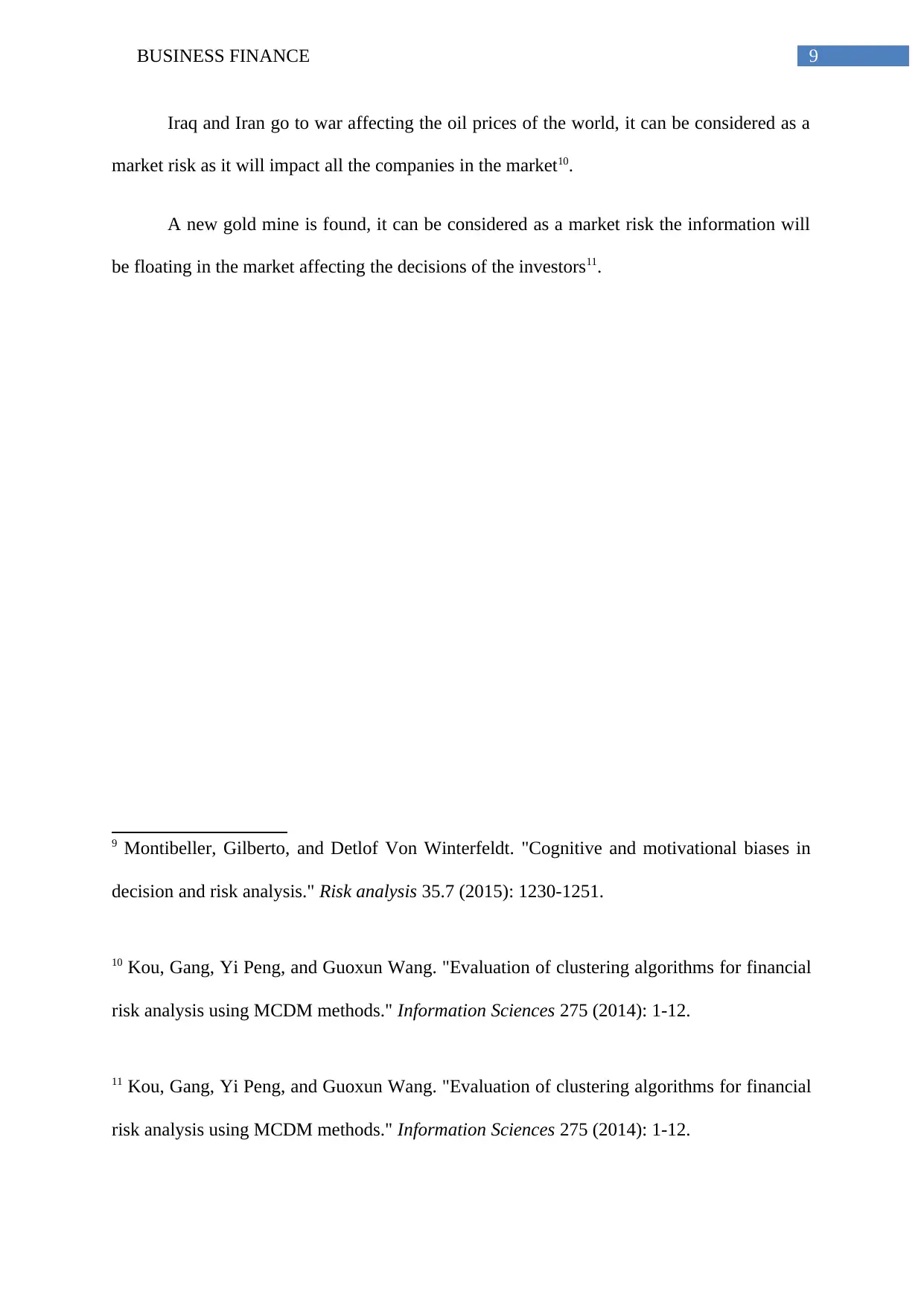
9BUSINESS FINANCE
Iraq and Iran go to war affecting the oil prices of the world, it can be considered as a
market risk as it will impact all the companies in the market10.
A new gold mine is found, it can be considered as a market risk the information will
be floating in the market affecting the decisions of the investors11.
9 Montibeller, Gilberto, and Detlof Von Winterfeldt. "Cognitive and motivational biases in
decision and risk analysis." Risk analysis 35.7 (2015): 1230-1251.
10 Kou, Gang, Yi Peng, and Guoxun Wang. "Evaluation of clustering algorithms for financial
risk analysis using MCDM methods." Information Sciences 275 (2014): 1-12.
11 Kou, Gang, Yi Peng, and Guoxun Wang. "Evaluation of clustering algorithms for financial
risk analysis using MCDM methods." Information Sciences 275 (2014): 1-12.
Iraq and Iran go to war affecting the oil prices of the world, it can be considered as a
market risk as it will impact all the companies in the market10.
A new gold mine is found, it can be considered as a market risk the information will
be floating in the market affecting the decisions of the investors11.
9 Montibeller, Gilberto, and Detlof Von Winterfeldt. "Cognitive and motivational biases in
decision and risk analysis." Risk analysis 35.7 (2015): 1230-1251.
10 Kou, Gang, Yi Peng, and Guoxun Wang. "Evaluation of clustering algorithms for financial
risk analysis using MCDM methods." Information Sciences 275 (2014): 1-12.
11 Kou, Gang, Yi Peng, and Guoxun Wang. "Evaluation of clustering algorithms for financial
risk analysis using MCDM methods." Information Sciences 275 (2014): 1-12.
Paraphrase This Document
Need a fresh take? Get an instant paraphrase of this document with our AI Paraphraser
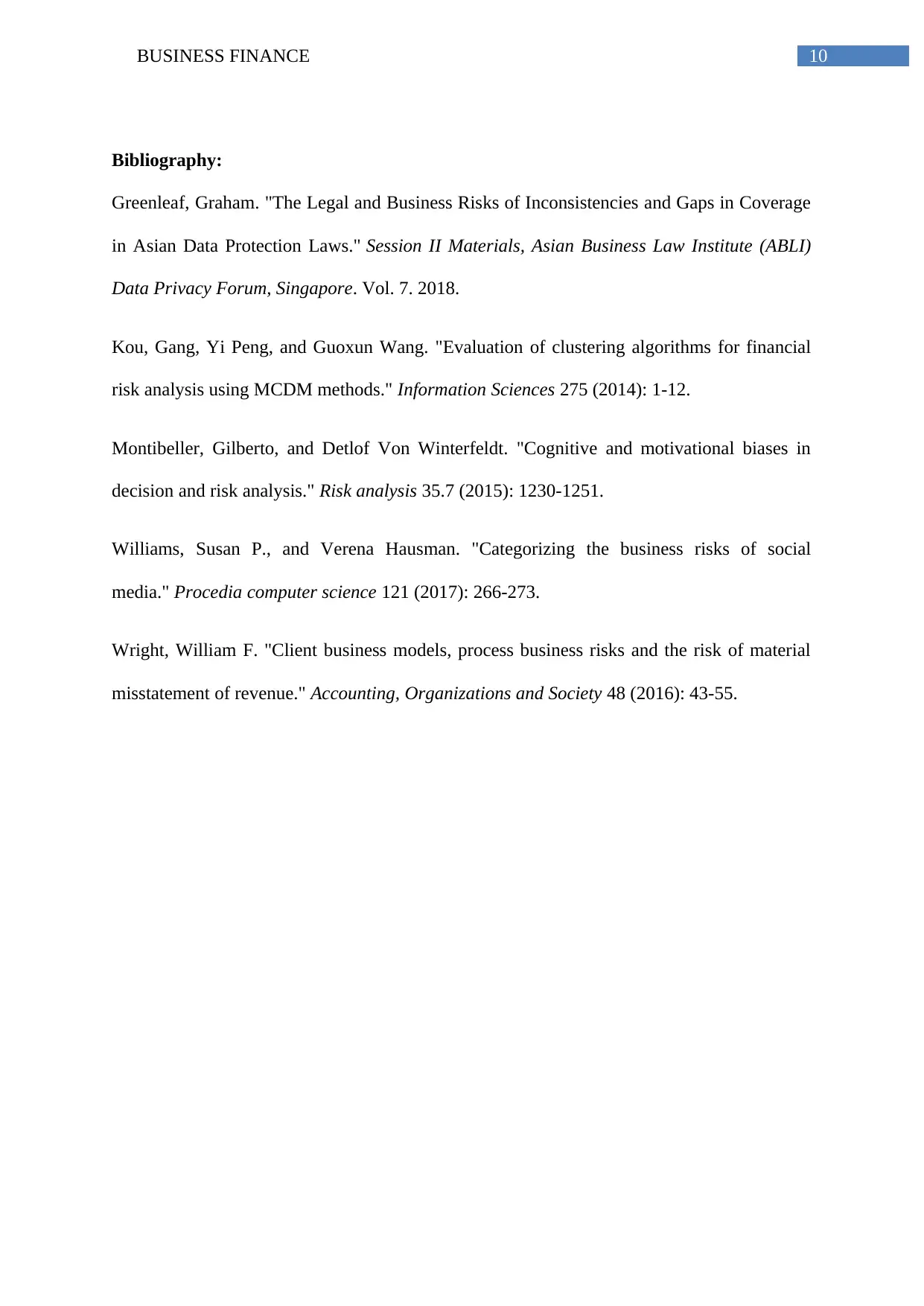
10BUSINESS FINANCE
Bibliography:
Greenleaf, Graham. "The Legal and Business Risks of Inconsistencies and Gaps in Coverage
in Asian Data Protection Laws." Session II Materials, Asian Business Law Institute (ABLI)
Data Privacy Forum, Singapore. Vol. 7. 2018.
Kou, Gang, Yi Peng, and Guoxun Wang. "Evaluation of clustering algorithms for financial
risk analysis using MCDM methods." Information Sciences 275 (2014): 1-12.
Montibeller, Gilberto, and Detlof Von Winterfeldt. "Cognitive and motivational biases in
decision and risk analysis." Risk analysis 35.7 (2015): 1230-1251.
Williams, Susan P., and Verena Hausman. "Categorizing the business risks of social
media." Procedia computer science 121 (2017): 266-273.
Wright, William F. "Client business models, process business risks and the risk of material
misstatement of revenue." Accounting, Organizations and Society 48 (2016): 43-55.
Bibliography:
Greenleaf, Graham. "The Legal and Business Risks of Inconsistencies and Gaps in Coverage
in Asian Data Protection Laws." Session II Materials, Asian Business Law Institute (ABLI)
Data Privacy Forum, Singapore. Vol. 7. 2018.
Kou, Gang, Yi Peng, and Guoxun Wang. "Evaluation of clustering algorithms for financial
risk analysis using MCDM methods." Information Sciences 275 (2014): 1-12.
Montibeller, Gilberto, and Detlof Von Winterfeldt. "Cognitive and motivational biases in
decision and risk analysis." Risk analysis 35.7 (2015): 1230-1251.
Williams, Susan P., and Verena Hausman. "Categorizing the business risks of social
media." Procedia computer science 121 (2017): 266-273.
Wright, William F. "Client business models, process business risks and the risk of material
misstatement of revenue." Accounting, Organizations and Society 48 (2016): 43-55.
1 out of 11
Related Documents
Your All-in-One AI-Powered Toolkit for Academic Success.
+13062052269
info@desklib.com
Available 24*7 on WhatsApp / Email
![[object Object]](/_next/static/media/star-bottom.7253800d.svg)
Unlock your academic potential
Copyright © 2020–2025 A2Z Services. All Rights Reserved. Developed and managed by ZUCOL.





